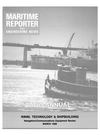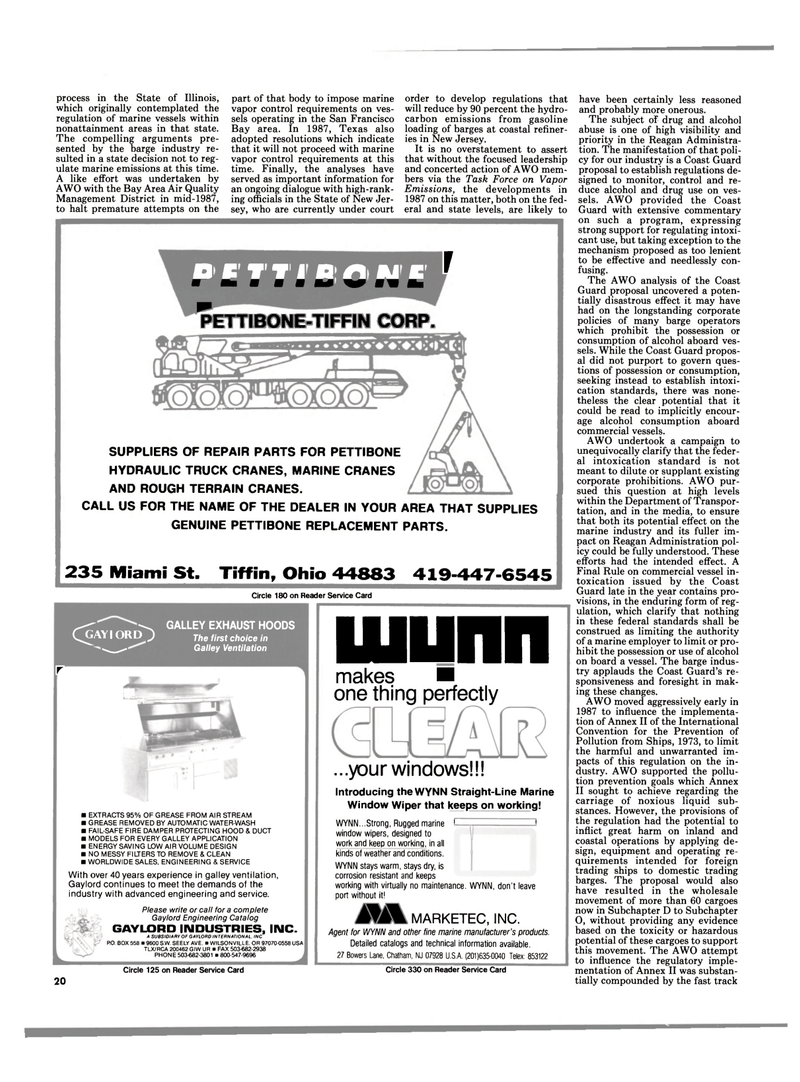
Page 18: of Maritime Reporter Magazine (March 1988)
Read this page in Pdf, Flash or Html5 edition of March 1988 Maritime Reporter Magazine
process in the State of Illinois, which originally contemplated the regulation of marine vessels within nonattainment areas in that state.
The compelling arguments pre- sented by the barge industry re- sulted in a state decision not to reg- ulate marine emissions at this time.
A like effort was undertaken by
AWO with the Bay Area Air Quality
Management District in mid-1987, to halt premature attempts on the part of that body to impose marine vapor control requirements on ves- sels operating in the San Francisco
Bay area. In 1987, Texas also adopted resolutions which indicate that it will not proceed with marine vapor control requirements at this time. Finally, the analyses have served as important information for an ongoing dialogue with high-rank- ing officials in the State of New Jer- sey, who are currently under court order to develop regulations that will reduce by 90 percent the hydro- carbon emissions from gasoline loading of barges at coastal refiner- ies in New Jersey.
It is no overstatement to assert that without the focused leadership and concerted action of AWO mem- bers via the Task Force on Vapor
Emissions, the developments in 1987 on this matter, both on the fed- eral and state levels, are likely to
PETTIBONE f ^ETTIBONE-TIFFIN CORP.
SUPPLIERS OF REPAIR PARTS FOR PETTIBONE
HYDRAULIC TRUCK CRANES, MARINE CRANES
AND ROUGH TERRAIN CRANES.
CALL US FOR THE NAME OF THE DEALER IN YOUR AREA THAT SUPPLIES
GENUINE PETTIBONE REPLACEMENT PARTS. 235 Miami St. Tiffin, Ohio 44883 419-447-6545
Circle 180 on Reader Service Card
GALLEY EXHAUST HOODS (^AYIORLT) The first choice in
Galley Ventilation r • EXTRACTS 95% OF GREASE FROM AIR STREAM • GREASE REMOVED BY AUTOMATIC WATER-WASH • FAIL-SAFE FIRE DAMPER PROTECTING HOOD & DUCT • MODELS FOR EVERY GALLEY APPLICATION • ENERGY SAVING LOW AIR VOLUME DESIGN • NO MESSY FILTERS TO REMOVE & CLEAN • WORLDWIDE SALES, ENGINEERING & SERVICE
With over 40 years experience in galley ventilation,
Gaylord continues to meet the demands of the industry with advanced engineering and service.
Please write or call for a complete
Gaylord Engineering Catalog
GAYLORD INDUSTRIES, INC.
A SUBSIDIARY OF GAYLORD INTERNATIONAL INC
P.O. BOX 558 • 9600 S.W. SEELY AVE. • WILSONVILLE. OR 97070-0558 USA
TLX/RCA 200462 GIW UR • FAX 503-682-2938
PHONE 503-682-3801 • 800-547-9696 uiunn makes • one thing perfectly ...your windows!!!
Introducing theWYNN Straight-Line Marine
Window Wiper that keeps on working! • WYNN...Strong, Rugged marine E window wipers, designed to work and keep on working, in all kinds of weather and conditions.
WYNN stays warm, stays dry, is corrosion resistant and keeps working with virtually no maintenance. WYNN, don't leave port without it! ifA MARKETEC, INC.
Agent for WYNN and other fine marine manufacturer's products.
Detailed catalogs and technical information available. 27 Bowers Lane, Chatham, NJ 07928 U.S.A. (201)635-0040 Telex: 853122
Circle 125 on Reader Service Card Circle 330 on Reader Service Card 20 have been certainly less reasoned and probably more onerous.
The subject of drug and alcohol abuse is one of high visibility and priority in the Reagan Administra- tion. The manifestation of that poli- cy for our industry is a Coast Guard proposal to establish regulations de- signed to monitor, control and re- duce alcohol and drug use on ves- sels. AWO provided the Coast
Guard with extensive commentary on such a program, expressing strong support for regulating intoxi- cant use, but taking exception to the mechanism proposed as too lenient to be effective and needlessly con- fusing.
The AWO analysis of the Coast
Guard proposal uncovered a poten- tially disastrous effect it may have had on the longstanding corporate policies of many barge operators which prohibit the possession or consumption of alcohol aboard ves- sels. While the Coast Guard propos- al did not purport to govern ques- tions of possession or consumption, seeking instead to establish intoxi- cation standards, there was none- theless the clear potential that it could be read to implicitly encour- age alcohol consumption aboard commercial vessels.
AWO undertook a campaign to unequivocally clarify that the feder- al intoxication standard is not meant to dilute or supplant existing corporate prohibitions. AWO pur- sued this question at high levels within the Department of Transpor- tation, and in the media, to ensure that both its potential effect on the marine industry and its fuller im- pact on Reagan Administration pol- icy could be fully understood. These efforts had the intended effect. A
Final Rule on commercial vessel in- toxication issued by the Coast
Guard late in the year contains pro- visions, in the enduring form of reg- ulation, which clarify that nothing in these federal standards shall be construed as limiting the authority of a marine employer to limit or pro- hibit the possession or use of alcohol on board a vessel. The barge indus- try applauds the Coast Guard's re- sponsiveness and foresight in mak- ing these changes.
AWO moved aggressively early in 1987 to influence the implementa- tion of Annex II of the International
Convention for the Prevention of
Pollution from Ships, 1973, to limit the harmful and unwarranted im- pacts of this regulation on the in- dustry. AWO supported the pollu- tion prevention goals which Annex
II sought to achieve regarding the carriage of noxious liquid sub- stances. However, the provisions of the regulation had the potential to inflict great harm on inland and coastal operations by applying de- sign, equipment and operating re- quirements intended for foreign trading ships to domestic trading barges. The proposal would also have resulted in the wholesale movement of more than 60 cargoes now in Subchapter D to Subchapter
O, without providing any evidence based on the toxicity or hazardous potential of these cargoes to support this movement. The AWO attempt to influence the regulatory imple- mentation of Annex II was substan- tially compounded by the fast track

 17
17

 19
19
